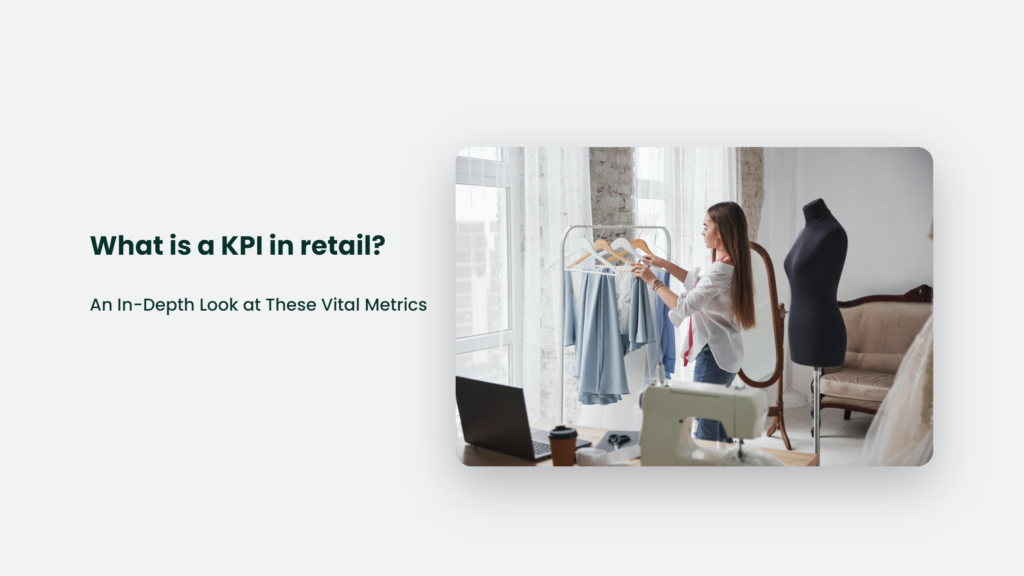

What is a KPI in Retail? An In-Depth Look at These Vital Metrics

As Seen On
Let’s be honest – retail can be a fickle beast. One day, you’re riding high on profits; the next, you’re staring down the barrel of bankruptcy. I’ve seen it happen to countless businesses over the years. So, how do you make sure your retail operation doesn’t become another statistic? You track the hell out of your key performance indicators (KPIs).
Now, I know some of you are rolling your eyes right now. “KPIs? How boring can you get?” Well, strap in, folks, because understanding KPIs in retail could mean the difference between going bankrupt or laughing all the way to the bank.
I will break down exactly what is a KPI in retail, why they matter, and how to track them effectively. Get ready for a wild ride into the fascinating world of retail metrics!

What is a KPI in Retail?
KPI stands for “key performance indicator”. Essentially, it’s a metric measuring how well you achieve a specific business objective. Some common examples of business objectives include:
- Increasing sales revenue
- Reducing costs
- Improving customer satisfaction
The KPIs you track should directly relate to these goals. For example, if your goal is to increase sales revenue, your KPI could be total monthly sales.KPIs come in all shapes and sizes – percentages, dollar amounts, ratios, etc. The important thing is choosing KPIs that truly reflect progress towards your most important business goals.
Why Should You Care About Retail KPIs?
I know tracking metrics seems about as exciting as watching paint dry. But retail KPIs give you invaluable insight into what’s working, what’s not, and where there’s room for improvement.
Without measuring KPIs, you’re flying blind – making decisions based on guesses and intuition rather than cold, hard data.
That’s a recipe for disaster in the ultra-competitive retail industry. Just ask Blockbuster how well ignoring metrics worked out for them.
Here are some key reasons you need to track retail KPIs:
Spot Negative Trends Early
The earlier you identify declines in key metrics, the sooner you can intervene to turn things around. You want to realize there’s a problem before sales have plummeted by 50%. Regular KPI monitoring allows you to spot downward trends when they first emerge and take corrective action.
Quantify Progress Towards Goals
How will you know if all your work is paying off? You track KPIs related to your goals, of course! Having concrete metrics eliminates guesswork and shows exactly how much progress you’re making.
Identify What’s Working
Tracking KPIs over time lets you see which initiatives correspond to positive trends. If online sales increased after launching an email marketing campaign, you know that campaign was effective. Use this data to double down on what’s working.
Optimize Resource Allocation
Tracking KPIs helps determine where to direct money and effort for maximum impact. If emails drive sales, but social media isn’t, invest more in email marketing. KPIs take the speculation out of resource allocation.
Benchmark Performance
KPIs allow you to benchmark your performance over time. You can compare this week’s sales to last month’s to see growth or this year’s customer retention rate to last year’s. Benchmarking with KPIs helps assess improvement.
Uncover Problem Areas
Declining KPIs shine a spotlight on parts of your business that need help. If online conversion rates drop, you know it’s time to overhaul your website. Falling customer retention means your customer service needs work. KPIs make it obvious where additional attention is required.
As you can see, regularly monitoring KPIs is crucial for identifying opportunities and issues early. It provides the data needed to make intelligent strategic decisions. Simply put, you can only effectively manage a retail business by tracking KPIs. It would be like navigating unfamiliar streets without a map – you might get lucky, but chances are you’ll end up lost.
The Top Retail KPIs You Should Be Tracking
Hopefully, I’ve convinced you that retail KPIs deserve your attention. Now, let’s get into the metrics that matter for retail businesses. The KPIs you track should be directly tied to your core retail objectives around sales, costs, and customer satisfaction.
Here are the top retail KPIs every store should be monitoring:
Sales KPIs
- Total revenue – Total money generated from sales over some time. Aim for steady monthly growth.
- Same-store sales – Revenue from stores open for at least 12 months. Excludes new store sales.
- Average order value – Total sales revenue divided by the number of orders. Higher values mean more spending per order.
- Average units per transaction – Number of items purchased per order on average. More units are better.
- Conversion rate – Percentage of store visitors who make a purchase. Higher is better.
- Sales per square foot – Total store sales divided by square footage. Benchmark against similar stores.
Customer KPIs
- Net promoter score – Customer loyalty metric based on likelihood to recommend. Higher is better.
- Churn rate – Percentage of customers lost over a period. Lower churn is better.
- Customer lifetime value – Revenue generated per customer over a lifetime. Aim to increase CLV.
- Customer satisfaction – CSAT survey scores. Percentage of “satisfied” responses. Higher is better.
- Customer retention rate – Percentage of customers retained over time. Higher retention is good.
Cost KPIs
- Product margin – Percentage of product price that is profit. Varies by product category.
- Operating costs – Total overhead costs to run stores. Aim to reduce where possible.
- Inventory turnover – How fast inventory sells. Higher turnover means lower storage costs.
- Shrinkage – Percentage of inventory lost to theft/damage annually. Lower is better.
- Labour costs – Total wages divided by sales. A lower percentage is better for profitability.
Online KPIs
- Website traffic – Total visits to the online store. More traffic provides more sales potential.
- Bounce rate – Percentage of visitors who leave after one page. A lower bounce is better.
- Page views per visit – Average number of pages viewed per visit. More pages are better.
- Email open rate – Percentage of emails opened by subscribers. Higher open rates mean more engagement.
- Email clickthrough rate – Percentage of people who click links in emails. Higher shows your content is resonating.
- Social media reach – Total people who see social posts. Wider reach drives more traffic.
- Social media engagement – Likes, shares, comments on posts. More shows your content resonates.
Inventory KPIs
- Stockout percentage – Percentage of time a product is out of stock. Lower is better for sales.
- Deadstock – Percentage of stale inventory not selling. Lower dead stock is ideal.
- Stock turn – How many times is inventory sold annually. A higher turnover is better.
- Weeks of supply – Weeks it would take to sell all inventory. Lower weeks are preferable.
- Purchase order cycle time – Time from order to delivery. Faster cycle times are better.
As you can see, there are a ton of KPIs that provide valuable insights into retail performance. Only try to track them some at a time – select the ones most relevant to your current business objectives and phase in additional metrics over time.
How to Track and Analyze Retail KPIs Effectively
Alright, now you know which retail KPIs to track. But simply looking at a bunch of numbers won’t do much good on its own. You need to analyze trends and drill into the causes behind changes in metrics.
Here are some tips for tracking and analyzing KPIs effectively:
Automate Data Collection
Manually gathering different metrics from multiple sources takes time and effort. Use retail management software and analytics tools to automatically pull in KPI data. It saves time and ensures accuracy.
Set Targets
Determine specific goals or benchmarks for each KPI. It gives you something to measure performance against. For example, aim for a 60% email open rate.
Compare Over Time
Look at how KPIs change week-over-week, month-over-month, and year-over-year. It reveals positive and negative momentum.
Segment by Relevant Factors
Break KPIs down by product category, traffic source, customer segment, etc. See how metrics differ across these segments to spot issues and opportunities.
Identify Root Causes
Don’t just look at surface-level changes in KPIs. Analyze upstream data to identify the underlying factors driving the change.
Create Action Plans
Once you’ve identified a root cause, develop targeted initiatives to improve the KPI. Set a timeline and metrics-based goals.
Revisit and Refine
Continuously evaluate KPIs to determine if your actions are working. If not, try a new approach. Refine over time.
You can turn retail KPI data into concrete insights and actions with the right processes. But you must dig deeper than surface-level metrics to create a competitive advantage.
Frequently Asked Questions:
How can you improve poor-performing retail KPIs?
Analyze root causes, create targeted initiatives, and track results frequently. Common tactics include promotions, pricing changes, customer service improvements, and inventory adjustments.
What is a good retail KPI benchmark?
Benchmarks vary dramatically by retail vertical and product category. Compare your KPIs to industry averages and your historical numbers to gauge performance.
The Bottom Line
Tracking key performance indicators is a must for any successful retail operation. When leveraged effectively, retail KPIs provide the visibility needed to spot issues early, quantify progress, optimize decision making and ultimately drive growth.
While digging into metrics might not be the “sexiest” part of running a retail business, it’s one of the most important. The numbers don’t lie – you’re not managing effectively if you’re not measuring KPIs.
So, pull up your sales dashboards, set your KPI targets, and get analyzing. The insights you uncover could be the competitive advantage you need to pull ahead of the pack! Just don’t make me say I told you so when your company is going bankrupt, and you didn’t track your metrics. I tried to warn you!
Konger
Up until working with Casey, we had only had poor to mediocre experiences outsourcing work to agencies. Casey & the team at CJ&CO are the exception to the rule.
Communication was beyond great, his understanding of our vision was phenomenal, and instead of needing babysitting like the other agencies we worked with, he was not only completely dependable but also gave us sound suggestions on how to get better results, at the risk of us not needing him for the initial job we requested (absolute gem).
This has truly been the first time we worked with someone outside of our business that quickly grasped our vision, and that I could completely forget about and would still deliver above expectations.
I honestly can't wait to work in many more projects together!
Disclaimer
*The information this blog provides is for general informational purposes only and is not intended as financial or professional advice. The information may not reflect current developments and may be changed or updated without notice. Any opinions expressed on this blog are the author’s own and do not necessarily reflect the views of the author’s employer or any other organization. You should not act or rely on any information contained in this blog without first seeking the advice of a professional. No representation or warranty, express or implied, is made as to the accuracy or completeness of the information contained in this blog. The author and affiliated parties assume no liability for any errors or omissions.

